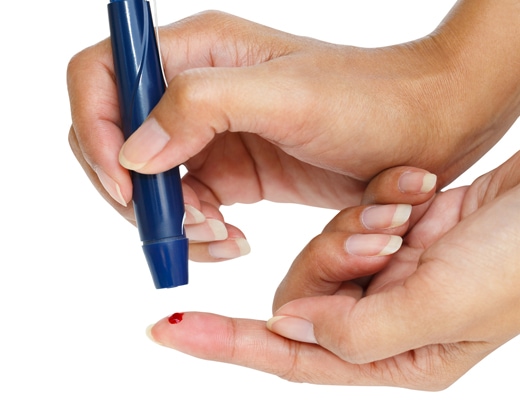
Diabetes – an insidious and dangerous degenerative disease of millions of people, and a similar number who are still unaware that they have it. The fifth highest cause of mortality and one of the main causes of cardiovascular, kidney and eye disease (including vision loss and bleeding of the eyeball), damage to the nervous system and blood vessels, hypertension, cerebral haemorrhage, hearing loss, slow-healing wounds, ulcers, comas (due to dehydration), gangrene, and limb amputation.
Symptoms and causes of diabetes
Diabetes can develop in the body over many years, showing no signs. Many people live with this disease without even knowing it. Therefore, if you notice:
- increased thirst + frequent urination,
- weight loss (with a normal appetite),
- sight problems,
- irritability, fatigue and drowsiness,
- intimacy problems,
- skin problems (itching, inflammation, dryness),
- tingling/temporary loss of sensation in the feet,
do an Elemental Hair Analysis. This will allow an accurate diagnosis of these problems.
There are many causes of diabetes. In addition to the ones that are best known, we must add heavy metal burden on the body and a lack/deficiency of minerals, which can be detected by EHA. Other cause of the disease include:
- lack of exercise,
- obesity,
- problems with the thyroid, liver and pancreas,
- inflammation of the body,
- excessive sugar consumption,
- genetic load.
However, these aren’t the only causes. If there were no other causes, then the incidence of this disease wouldn’t have increased by as much as 50% over the last decade. All the more so because today, people’s awareness is incomparably higher than it was a decade ago. So what are the other causes for the increase in cases of diabetes?

Has your doctor ever mentioned heavy metal burden? Did they mention that a lack or deficiency of specific minerals (i.e. correct ratios between them) can be an independent cause and promoter of the disease?
If they didn’t mention this, it doesn’t mean that the disease isn’t developing or that it won’t develop in the near future. You should know that the onset of diabetes (or any other disease) is always preceded by certain trends and tendencies. However, if you already have it, the possibility that it’ll never go away is much more likely if you ignore the role of heavy metals and minerals, which actually initiate and control the processes associated with diabetes. There’s more – they also initiate and control the development of pathological conditions that are widely considered to be the only causes for diabetes. (see above)
‘Unknown’ causes of diabetes
In order to understand the scientific observations on the role of heavy metals and minerals, we must first clarify what they do in the body. If heavy metals can be considered to be destructive, minerals can be considered to be beneficial. The reason is simple – without them, biochemical processes will not function properly. This is because they are their ‘spark plugs’ (catalysts) involved in, among others, sugar metabolism, and the building of tissues, hormones, and enzymes, etc. In other words, everything that is called ‘life’. Therefore, analysis of the body’s current supply of ‘bad’ and ‘good’ minerals can answer the question of whether standard medical or dietary recommendations for the treatment of diabetes are sufficient. It may turn out that they’re only a more-or-less correct theory that may prevent you from taking effective control over this dangerous disease. Here’s the reason:
‘Research aimed at comparing the level of micronutrients and macronutrients in subjects with type 2 diabetes and healthy subjects has shown that deficiencies of (specific) minerals, and the accumulation of heavy metals, have played an important role in the development of diabetes’ (Taylor and Francis, 2009). Analysis of the body’s response to the presence of toxic metals has shown the destructive impact of arsenic, cadmium, mercury, nickel and lead on the processes related to the development and control of diabetes.
Arsenic
This highly toxic element causes resistance to insulin, while increasing the level of oxidation. This process reduces the capacity of normal glucose metabolism, and the resistance of cells to insulin increases proportionately. The presence of arsenic in the body disrupts mineral and hormonal homeostasis, which scientists have recognised as another cause of the development of diabetesen.
Cadmium
It prevents the release of insulin, while destroying its receptors. It also demonstrates the ability to disrupt glucose metabolism processes. It can cause hyperglycaemia, decrease insulin production and increase the activity of liver enzymes involved in the process of production of (larger quantities of) glucose.
Mercury
The presence of the extremely toxic mercury in the body is one of the main reasons for the presence of sugar in urine. Mercury can cause diabetes without any assistance from other, similar, toxic metals; it can also abruptly change blood glucose levels, and destroy insulin-producing cells. Lead, which is close in the toxic metal family, can do exactly the same thing as mercury.
Nickel
Nickel can also cause effects similar to those above. The lower (or non-existent – as is often the case) the availability of antagonists of nickel and other heavy metals (e.g. zinc, molybdenum, magnesium, vanadium), the higher the concentration of heavy metals. Nickel prevents glucose from entering cells, and destroys the mechanism that regulates blood glucose levels.
Measures necessary in controlling diabetes – EHA
These types of observations make people with diabetes ask: what’s my heavy metal burden? What’s my supply of minerals that are supposed to protect me against heavy metals? Do I also belong to the group of 90% of people with mineral disorders?
Every doctor’s and dietician’s objective is to take control of blood sugar levels, and to stabilise sugar in cells. Your role is extremely important, because you’re the one who decides whether or not to listen to the recommendations.
Where should you start?
Regardless of what you’ve been doing until now, it’s just as important (or even more so) to check the heavy metal burden and the availability of the minerals that are involved in normalising the processes associated with diabetes. Ignorance of your own condition in this respect may be a serious obstacle to you gaining full control over the disease, or going into remission.
Elemental Hair Analysis (EHA)
Why EHA, and not, for example, a urine or blood test? There are many reasons, and one of the most important is the reliability of the reading. Blood tests are often invaluable. The problem is that the results reflect only the status at the given time and do not communicate what’s happening in the body over time and at cellular level. Blood only carries substances (e.g. vitamins, minerals, glucose, hormones etc.), while cells are the final recipient. And, even though a test that determines the level of glucose in the blood can be regarded as useful, it doesn’t answer basic questions, such as: why do its readings vary, or why is it present in urine? Why is the insulin circulating in the blood unable to bring it into the cells? These questions can be answered by assessing the level of ‘good’ and ‘bad’ minerals at cellular level.
How can we determine their status?
Do you remember? Blood only carriers the elements, while the cells are the recipients. Therefore, an analysis of ‘good’ and ‘bad’ minerals in the hair is recommended, because minerals that are present in too-large quantities in the body and are an obstacle, the body transports (eliminates) into the hair. Conversely, those that the body is deficient in (due to inadequate nutrition and/or supplementation) are present in the hair in trace amounts or below the norm.
This simple mechanism has been used by the most-eminent American doctors and biochemists with doctors, dieticians and their patients in mind. With the EHA tool, they’ll be able to see inside cells, which is where disease begins and health ends. With spectrometry and EHA, diabetics are not the only ones who can accurately check the body’s toxic load (which allows them to individually choose supplements according to their needs*), or define their own metabolic predispositions based on which nutritional programmes should be determined.
Diabetes is not a death sentence. Similar to other diseases, diabetes also has its causes, which should be identified and completely eliminated.
* According to the ‘Physicians Reference Book’ (USA), nutrient supplements in liquid form (isotonic) are up to 95% absorbed (already in the mouth). However, for solid and tablet forms, this figure is 5% to 18%.
Prepared by dietician, consultant, promoter of environmental medicine, author of an individual interpretation of EHA results and books on causal treatment (‘Od lekarza do grabarza – ‘From the doctor to the gravedigger’, ‘Ekomedycyna’ – ‘Ecomedicine’, ‘Zdrowa kobieta to zdrowa rodzina’ – ‘A Healthy Woman is a Healthy Family’), specialist in the field of non-invasive cleansing and stimulation of the lymphatic system – Jerzy Maslanky, in cooperation with the Lifeline Diag laboratory.














